Predictions & Data for this entry
| Model: std | climate: B | migrate: | phylum: |
| COMPLETE = 2.5 | ecozone: TA | food: biCi | class: |
| MRE = 0.049 | habitat: 0iThh | gender: Dg | order: |
| SMSE = 0.007 | embryo: Tt | reprod: O | family: |
Zero-variate data
| Data | Observed | Predicted | (RE) | Unit | Description | Reference |
|---|---|---|---|---|---|---|
| ab | 36 | 35.36 | (0.0179) | d | age at birth | Burn2018 |
| ap | 126 | 144.1 | (0.1435) | d | age at puberty | Bamf1992 |
| am | 1095 | 1095 | (1.553e-05) | d | life span | Bamf1992 |
| Lb | 2.35 | 2.287 | (0.02662) | cm | snout to vent length at birth | Burn2018 |
| Lp | 4 | 3.833 | (0.04181) | cm | snout to vent length at puberty | Bamf1992 |
| Li | 5.2 | 5.02 | (0.03459) | cm | ultimate snout to vent length | Bamf1992 |
| Wwb | 0.58 | 0.5258 | (0.09347) | g | wet weight at birth | Burn2018 |
| Wwp | 2.5 | 2.473 | (0.01066) | g | wet weight at puberty | Bamf1992 |
| Wwi | 5.4 | 5.558 | (0.02922) | g | ultimate wet weight | Bamf1992 |
| Ri | 0.008219 | 0.008221 | (0.0002645) | #/d | maximum reprod rate | Bamf1992, Burn2018 |
Uni- and bivariate data
| Data | Figure | Independent variable | Dependent variable | (RE) | Reference |
|---|---|---|---|---|---|
| tL_Gf1h1 |  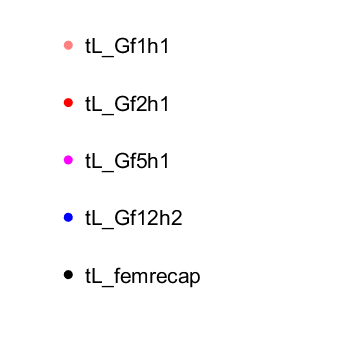 | time since birth | snout to vent length | (0.04016) | Burn2018 |
| tL_Gf2h1 |   | time since birth | snout to vent length | (0.02931) | Burn2018 |
| tL_Gf5h1 |   | time since birth | snout to vent length | (0.02737) | Burn2018 |
| tL_Gf12h2 |   | time since birth | snout to vent length | (0.05585) | Burn2018 |
| tL_femrecap |   | time since birth | snout to vent length | (0.05207) | Bamf2018 |
| tW_Gf1h1 | 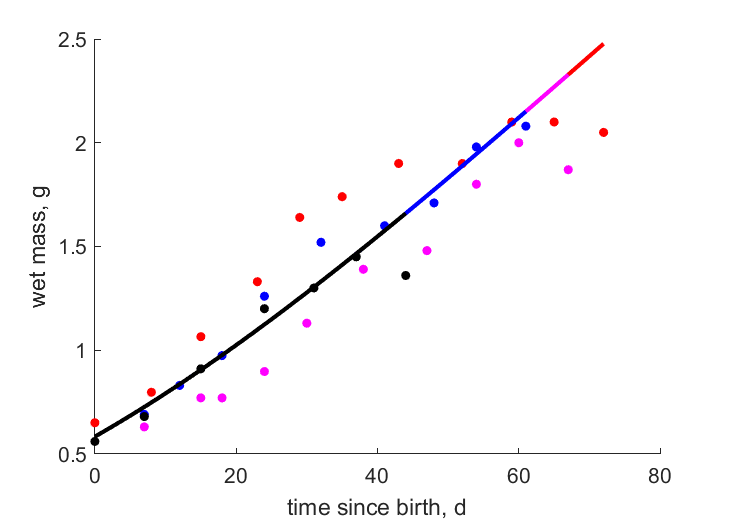  | time since birth | wet mass | (0.1221) | Burn2018 |
| tW_Gf2h1 |   | time since birth | wet mass | (0.1451) | Burn2018 |
| tW_Gf5h1 |   | time since birth | wet mass | (0.04433) | Burn2018 |
| tW_Gf12h2 |   | time since birth | wet mass | (0.06305) | Burn2018 |
| LW_Gf1h1 |  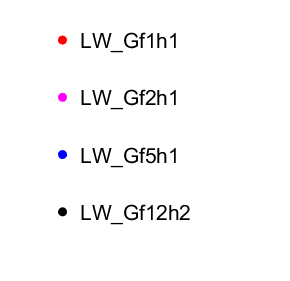 | snout vent length | wet mass | (0.05861) | Burn2018 |
| LW_Gf2h1 |   | snout vent length | wet mass | (0.07702) | Burn2018 |
| LW_Gf5h1 |   | snout vent length | wet mass | (0.0863) | Burn2018 |
| LW_Gf12h2 |   | snout vent length | wet mass | (0.1237) | Burn2018 |
| tL_Gf1h2 | 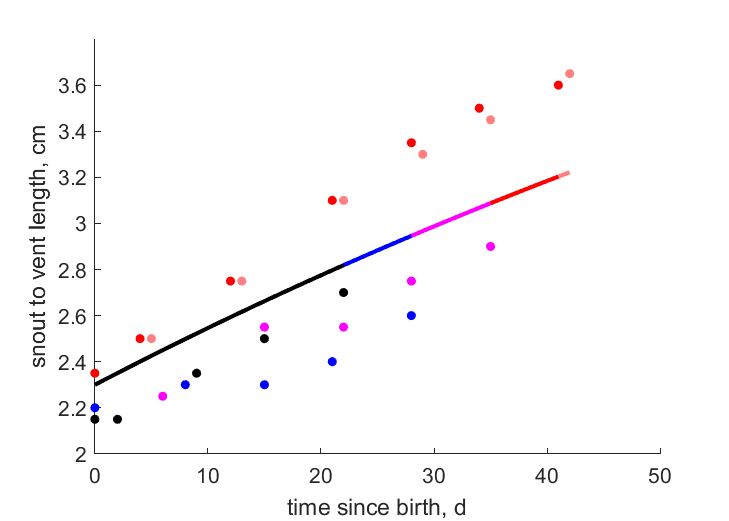 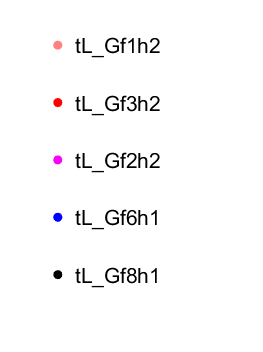 | time since birth | snout to vent length | (0.07884) | Burn2018 |
| tL_Gf3h2 |   | time since birth | snout to vent length | (0.08712) | Burn2018 |
| tL_Gf2h2 |   | time since birth | snout to vent length | (0.07356) | Burn2018 |
| tL_Gf6h1 |   | time since birth | snout to vent length | (0.119) | Burn2018 |
| tL_Gf8h1 |   | time since birth | snout to vent length | (0.06784) | Burn2018 |
| tW_Gf1h2 | 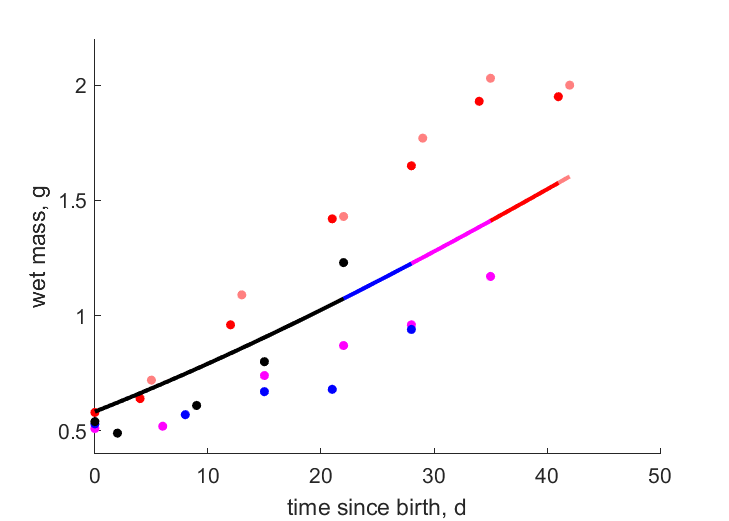 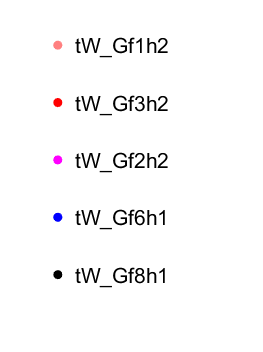 | time since birth | wet mass | (0.2245) | Burn2018 |
| tW_Gf3h2 |   | time since birth | wet mass | (0.2043) | Burn2018 |
| tW_Gf2h2 |   | time since birth | wet mass | (0.2378) | Burn2018 |
| tW_Gf6h1 |   | time since birth | wet mass | (0.3307) | Burn2018 |
| tW_Gf8h1 |   | time since birth | wet mass | (0.1626) | Burn2018 |
| LW_Gf1h2 | 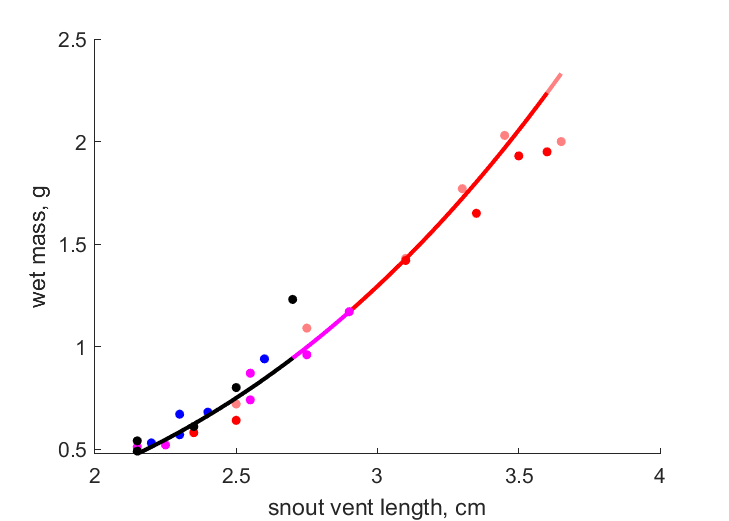 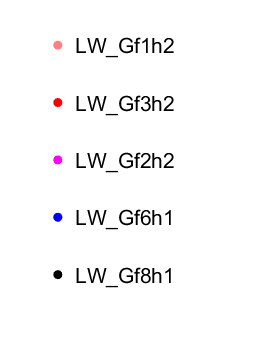 | snout vent length | wet mass | (0.06293) | Burn2018 |
| LW_Gf3h2 |   | snout vent length | wet mass | (0.08352) | Burn2018 |
| LW_Gf2h2 |   | snout vent length | wet mass | (0.04767) | Burn2018 |
| LW_Gf6h1 |   | snout vent length | wet mass | (0.06899) | Burn2018 |
| LW_Gf8h1 |   | snout vent length | wet mass | (0.1161) | Burn2018 |
| LW_B_Cool_F | 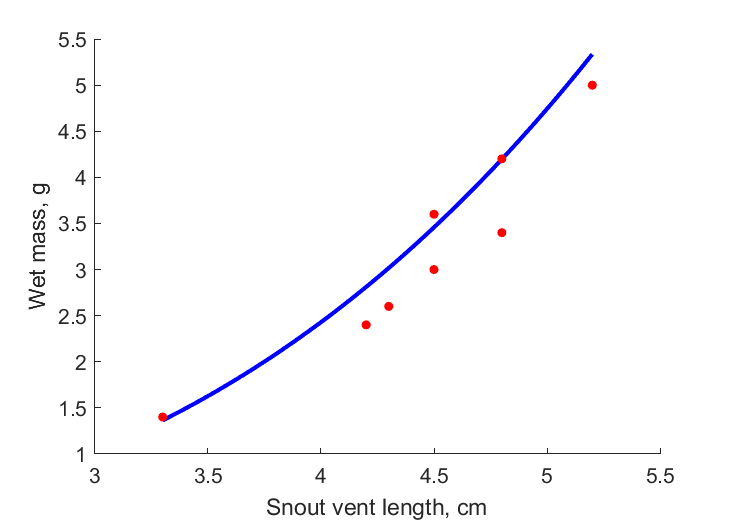  | Snout vent length | Wet mass | (0.08445) | Bamf2018 |
| L0Lt_B_Recap | 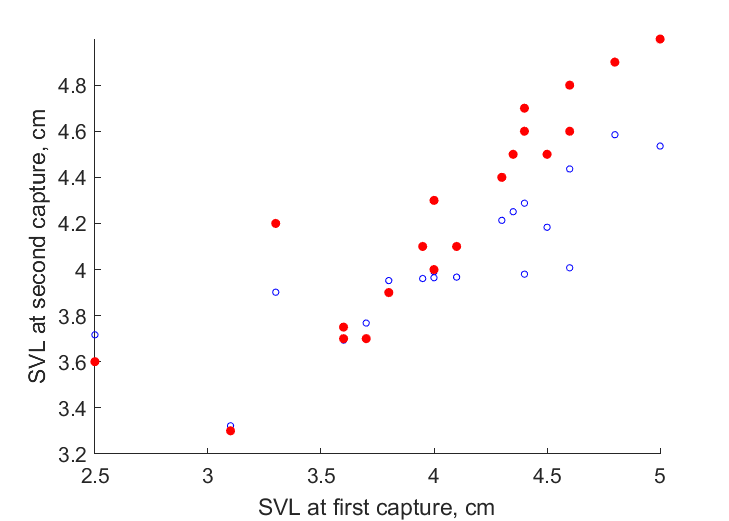  | SVL at first capture | SVL at second capture | (1.145) | Bamf2018 |
| tL_Gf1h1 |  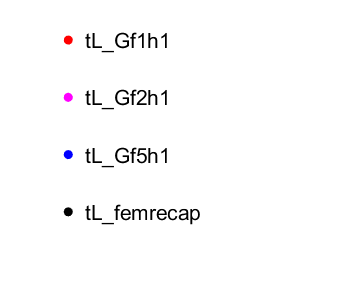 | time since birth | snout to vent length | (0.04016) | Burn2018 |
| tL_Gf2h1 |   | time since birth | snout to vent length | (0.02931) | Burn2018 |
| tL_Gf5h1 |   | time since birth | snout to vent length | (0.02737) | Burn2018 |
| tL_femrecap |   | time since birth | snout to vent length | (0.05207) | Bamf2018 |
| Tab |  | incubation temperature | age at birth | (0.0227) | Burn2018 |
Pseudo-data at Tref = 20°C
| Data | Generalised animal | Ctenophorus adelaidensis | Unit | Description |
|---|---|---|---|---|
| v | 0.02 | 0.01718 | cm/d | energy conductance |
| kap | 0.8 | 0.9084 | - | allocation fraction to soma |
| kap_R | 0.95 | 0.95 | - | reproduction efficiency |
| p_M | 18 | 157.8 | J/d.cm^3 | vol-spec som maint |
| k_J | 0.002 | 0.002 | 1/d | maturity maint rate coefficient |
| kap_G | 0.8 | 0.8007 | - | growth efficiency |
Discussion
- For animals cought in the wild (data: M. Bamford) the age was assumed
- Most of the wild data is for females; there is a difference in size between males and females. Data for (wild) males might be added at a later stage.
- Captive reared individuals were reared from eggs laid by wild females in captivity, and incubatedat two temperatures (as indicated). All juveniles were reared at same conditions.
- Food abundance for uni-variate data and zero-variate wild data was allowed to differ.
- This entry contains some unpublished data; If you plan to use it, please contact Hamish (hamish.burnett89@gmail.com)
Facts
- The Western heath dragon is one of the most common lizards in coastal Southwestern Australia. It lives in coastal heath, kwongan, and Banksia woodland habitats with sandy substrates. (Ref: Wiki)
- They are often one of the first vertebrates that appear after habitat restoration of (sand) mining sites in WA. (Ref: Bamf2018)
Bibliography